Your succulents are growing tall and leggy because they're not getting enough light, a condition called etiolation. When succulents don't receive their needed 5-6 hours of daily indirect sunlight, they stretch toward light sources, creating elongated stems with widely spaced leaves. This survival response weakens their structure and creates an unkempt appearance. While moving them to a brighter spot helps prevent stretching, there's much more you can do to restore your succulents' compact, healthy shape.
Understanding Etiolation in Succulents
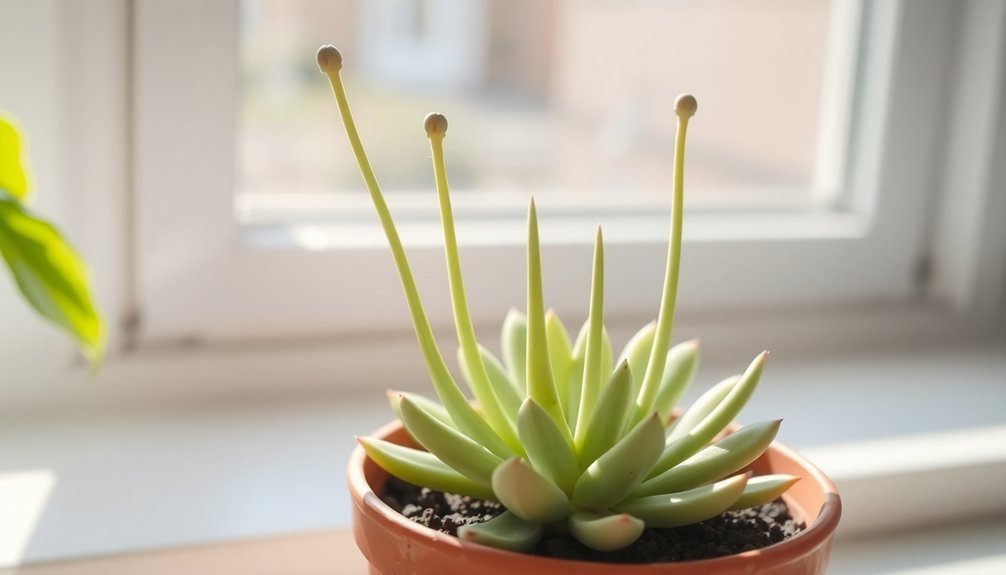
When your succulents start stretching upward with elongated stems and widely spaced leaves, they're likely experiencing etiolation. This common problem occurs when your plants don't receive enough light, causing them to stretch desperately toward available light sources.
You'll notice your once-compact succulents becoming pale and lanky, developing an unkempt appearance that signals they're struggling.
Insufficient sunlight is the primary cause of leggy growth, particularly in indoor settings where light may be limited. If you want to prevent etiolation, proper placement is essential – your succulents need 5-6 hours of indirect sunlight daily to maintain their natural shape.
Signs of Light Deprivation
Watch for tell-tale signs that your succulent isn't getting enough light, including stretched stems, wider gaps between leaves, and a noticeable lean toward light sources.
You'll also notice your plant's new growth appearing lighter in color, with leaves that spread outward instead of maintaining their typical compact form.
If you spot these changes early, you can quickly adjust your plant's location to prevent further etiolation and maintain its healthy, natural shape.
Early Warning Signals
Identifying light deprivation in your succulents early can prevent them from becoming permanently stretched and deformed.
When your plants aren't getting enough light, they'll display several telltale signs of etiolation. Watch for leaves bending toward light sources and increased spacing between leaves, as these are classic indicators of leggy succulents struggling with inadequate light.
- You'll feel frustrated watching your once-compact succulent stretch unnaturally tall.
- You'll worry as your plant's leaves become smaller and paler, losing their vibrant color.
- You'll recognize the urgency to act when leaves flatten and spread instead of maintaining their natural upright position.
Visual Growth Changes
The most obvious signs of light deprivation in succulents manifest through distinct visual changes in their growth patterns.
When your succulent doesn't get enough light, you'll notice it starting to grow tall with stretched-out stems and wider spaces between leaves. This leggy succulent appearance indicates your plant is desperately searching for more light.
Watch for new growth that appears lighter in color and smaller than usual leaves – these are clear indicators of a lack of sunlight.
You'll also spot your plant's leaves flattening out or spreading instead of maintaining their typical compact form.
If you see your succulent bending toward windows or light sources, or its leaves beginning to curl backward and droop, it's time to adjust your plant's lighting conditions.
Natural Causes of Succulent Stretching
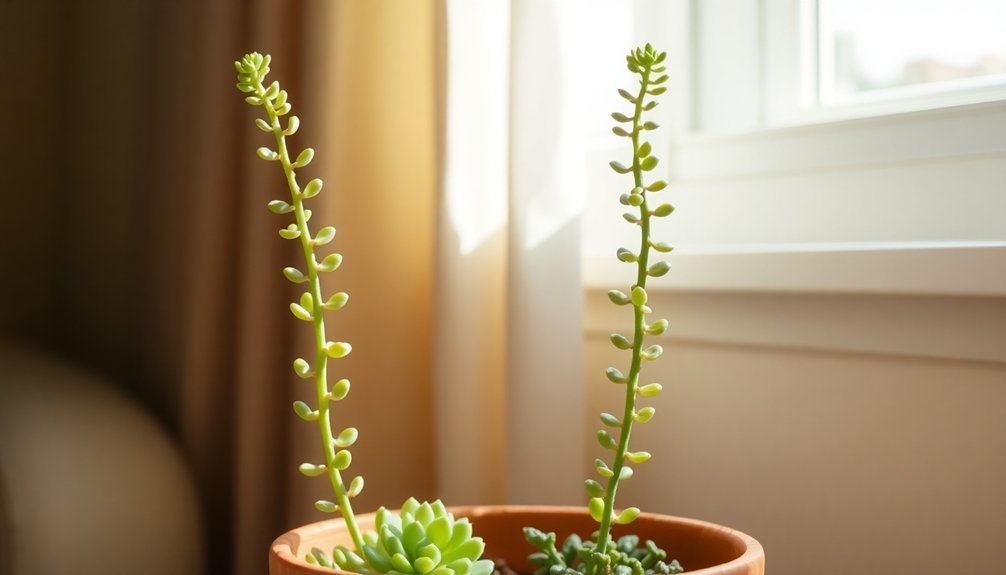
When succulents don't receive enough sunlight, they naturally respond by growing tall and stretched out in a process called etiolation. Your succulents will instinctively stretch toward available light sources, causing them to become leggy with elongated stems and widely spaced leaves.
This natural survival mechanism helps them search for better light conditions, though it often results in less attractive plants.
- Your once-compact succulent desperately reaching for light, showing you it's struggling to survive
- Each new leaf growing further apart, crying out for more sunshine
- The plant's desperate attempt to find light, transforming its shape before your eyes
Environmental factors like warm temperatures and excess moisture can make this stretching worse.
If you're noticing leggy growth, it's a clear sign your succulents aren't getting enough light, and you might need to evaluate a grow light or relocating them.
The Science Behind Leggy Growth
Your succulent's leggy growth occurs due to a process called phototropism, where plant hormones trigger cells to elongate as they search for adequate light.
When light is insufficient, your plant produces excess auxin (a growth hormone) that causes stems to stretch and leaves to space further apart, leading to the characteristic tall, sparse appearance.
This biological response reflects your succulent's natural survival mechanism, but it ultimately weakens the plant's structure and compromises its health.
Light-Seeking Plant Behavior
Understanding light-seeking behavior in succulents reveals a fascinating survival mechanism called etiolation. When your succulent isn't getting the light it needs, it'll start growing tall and stretched, desperately reaching toward the nearest light source.
You'll notice your once-compact plant developing longer stems and widely spaced leaves as it attempts to maximize its sun exposure.
- Your succulent's pale, elongated appearance is actually a cry for help – it's telling you it needs more sunlight to thrive.
- Each stretched stem represents your plant's determined effort to survive in less-than-ideal conditions.
- This natural adaptation shows how your succulent fights to grow new tissue in its quest for better lighting.
When you spot these changes in your plant's appearance, it's signaling that it needs more direct sunlight – ideally 5-6 hours daily – to maintain its healthy, compact form.
Hormonal Growth Response
Inside your succulent's stretched stems lies a complex hormonal dance, primarily orchestrated by a growth hormone called auxin. When your plant doesn't get enough light, auxin concentrates on the shaded sides of stems, triggering cells to elongate as they reach for available light sources.
This stretching isn't random – it's your plant's survival mechanism at work. The hormonal response causes your succulent to grow taller and leaner in an attempt to capture more light.
While auxin leads this process, another hormone called gibberellin joins in, further promoting stem elongation and contributing to that leggy appearance you're seeing.
Understanding this hormonal activity is essential because it shows that your succulent's stretched growth isn't just unsightly – it's a clear signal that your plant needs more light to thrive.
Prevention Strategies for Compact Growth
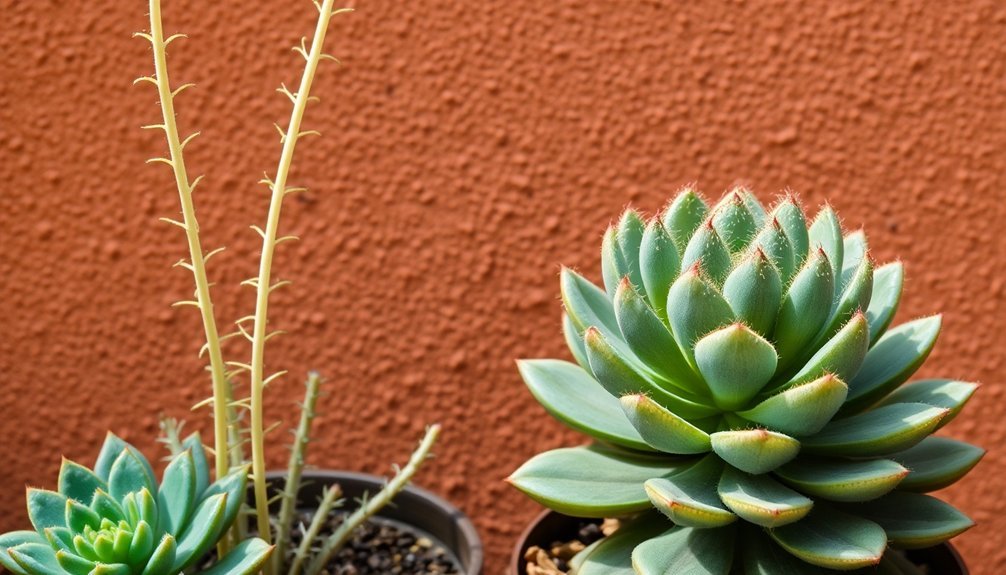
While succulents naturally thrive in desert environments, creating the right growing conditions will prevent them from becoming tall and leggy. To prevent leggy growth, place your plants where they'll receive 5-6 hours of indirect sunlight daily.
Use well-draining soil designed for succulents, and guarantee proper air circulation to mimic their natural habitat. Don't forget to prune leggy succulents when needed to encourage bushier growth.
- You'll feel proud watching your succulents develop a beautiful, compact shape when you rotate them regularly for even light exposure.
- You'll experience the joy of seeing healthy, vibrant growth as you maintain ideal temperature and humidity levels.
- You'll gain confidence knowing you're providing the perfect environment by monitoring and adjusting conditions as needed.
Best Light Conditions for Healthy Succulents
To maintain vibrant and compact succulents, proper light exposure serves as the cornerstone of their care. The best light conditions for your succulents include bright indirect sunlight for 5-6 hours daily. You'll want to place them near south or west-facing windows to maximize their light intake and prevent leggy growth.
| Location | Light Quality | Growth Result |
|---|---|---|
| South Window | Bright Direct | Compact, Colorful |
| West Window | Bright Indirect | Healthy, Balanced |
| North Window | Low Light | Stretched, Leggy |
| Under Grow Light | Controlled | Even Growth |
If you're noticing your succulents stretching or developing increased space between leaves, they're likely not getting enough light. During winter months, you'll need to supplement natural light with grow lights to maintain healthy growth patterns and prevent etiolation.
Saving Stretched Plants Through Propagation
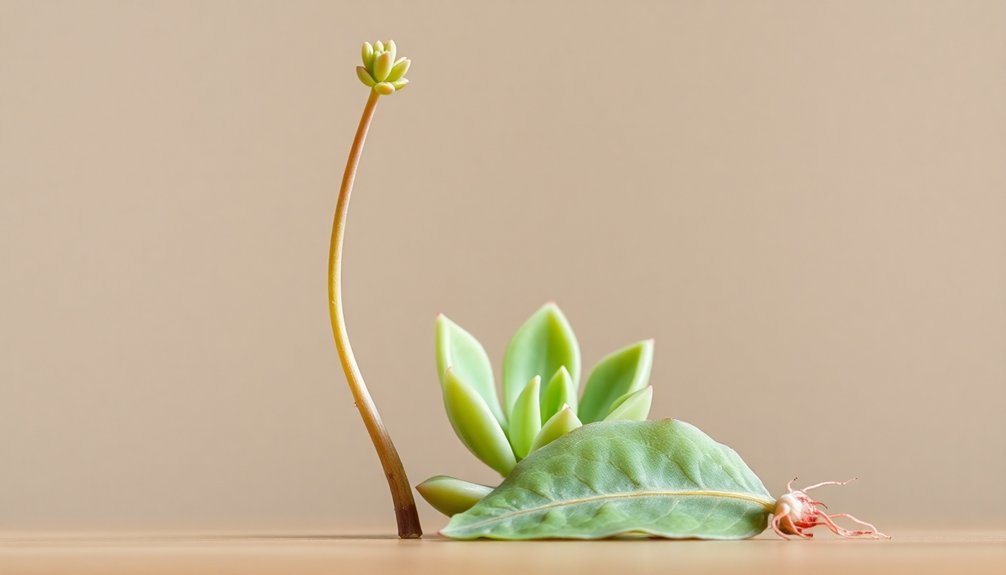
When your succulents have already stretched due to insufficient light, propagation offers an effective solution to restore their compact form.
You'll need to cut the leggy stem about 1-2 inches above healthy leaves, making certain to remove lower leaves from your cuttings to prevent rot. Let the cut ends dry and callous for 1-2 days before planting them in well-draining soil.
- Watch with excitement as your cuttings develop new roots and transform into compact, healthy plants
- Feel accomplished knowing you've saved your stretched succulents from becoming unsightly
- Experience the joy of multiplying your plant collection through successful propagation
Place your newly planted cuttings where they'll receive bright, indirect sunlight, and water them sparingly.
This careful approach to propagation will help guarantee your succulents grow strong and maintain their desired shape.
Proper Pruning Techniques
Since leggy succulents require precise pruning for successful rejuvenation, mastering the proper cutting technique is essential. When your succulents are getting leggy, grab your pruning shears and make clean cuts, leaving 1-2 inches at the base of the plant with a few leaves intact. Remove any lower leaves to encourage compact growth.
| Step | Action |
|---|---|
| 1 | Cut stem with clean shears, leaving 2-3 leaves |
| 2 | Remove leaves below rosette |
| 3 | Let cut ends callous for 1-2 days |
| 4 | Plant in well-draining soil mix |
After cutting, you'll want to save the removed leaves for propagating succulents. Let both the cut stem and leaves dry for 1-2 days before replanting. Don't water your newly pruned succulent for at least a week, and keep an eye on its light exposure to prevent future stretching.
Ideal Growing Environments
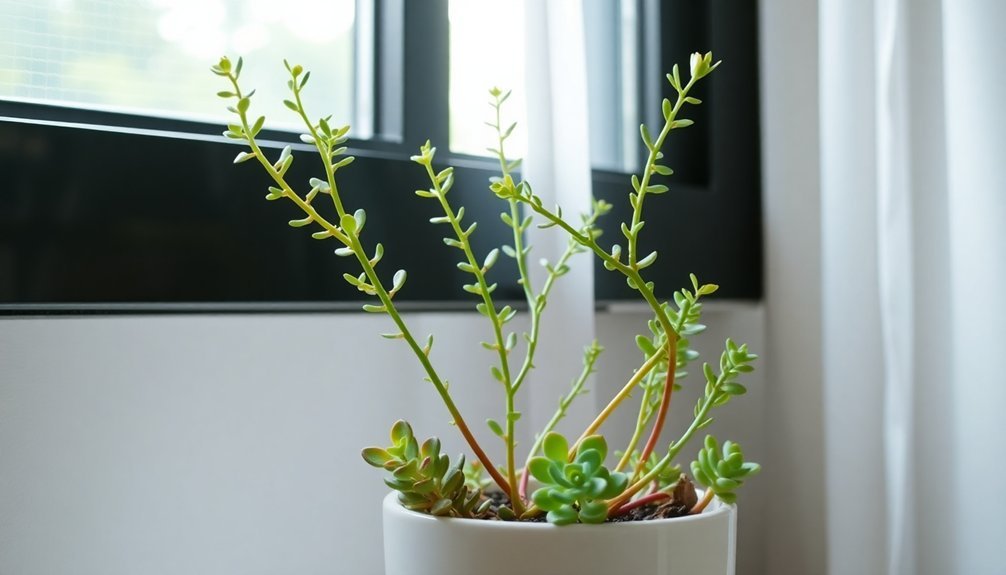
You'll want to place your succulents in a spot that receives 5-6 hours of bright, indirect sunlight daily, maintaining temperatures between 60-80°F for ideal growth.
Your soil choice plays a critical role, so use a well-draining cactus or succulent mix to prevent root rot and guarantee proper moisture management.
If you're growing succulents indoors where natural light is limited, consider adding grow lights to provide the necessary illumination and prevent your plants from becoming leggy.
Light and Temperature Requirements
To maintain healthy, compact succulents, understanding their light and temperature requirements is essential. Your plants need 5-6 hours of bright, indirect sunlight daily to grow properly.
If you notice your succulents stretching or developing increased space between leaves, they're likely not getting enough light. During winter months, you'll need to take into account using grow lights to supplement the reduced natural sunlight indoors.
Keep your succulents in temperatures between 60°F to 80°F for ideal growth.
Here's what happens when you don't meet their light needs:
- Your beloved plants will desperately stretch toward light sources
- Their once-beautiful compact form will become distorted and leggy
- Their overall health will decline, leaving you with weak, unattractive plants
Monitor light conditions regularly and adjust your succulents' positioning to prevent these issues.
Proper Soil Mix
While light plays an essential role in succulent health, proper soil composition serves as the foundation for preventing leggy growth. Your succulents need a well-draining soil mix that combines cactus soil, perlite, and coarse sand to guarantee excess moisture doesn't linger around the roots.
To create the ideal growing environment, you'll want to maintain a soil pH between 6.0 and 6.8. This balance helps your succulents access essential nutrients while preventing root rot.
When you're selecting containers, always choose ones with drainage holes to complement your soil mix. You can also enhance your soil by adding organic materials, but don't compromise the drainage properties.
Recovery Methods for Elongated Growth
Restoring leggy succulents to their compact form requires careful pruning and proper replanting techniques. Start by cutting the stem 1-2 inches above the soil, leaving 2-3 leaves intact. Remove excess leaves from the lower stem, promoting a more compact shape. Before replanting, let the cut ends callous for 1-2 days to prevent rot.
- You'll feel a sense of accomplishment watching your succulent transform from lanky to lush.
- The satisfaction of saving your plant will inspire you to provide better care.
- You'll be proud of your gardening skills as new growth emerges.
Once calloused, replant your cuttings in well-draining succulent soil. Don't water for the first week to allow proper root development.
To prevent future legginess, make sure your plant receives 5-6 hours of indirect sunlight daily. If natural light is limited, consider using grow lights to maintain healthy growth.
Maintaining Healthy Plant Shape
Once you've rescued your leggy succulent, maintaining its compact shape requires consistent care and attention to light conditions.
Place your plant in a bright windowsill where it'll receive 5-6 hours of indirect sunlight daily to prevent future stretching.
Keep an eye on your succulent's growth patterns and don't hesitate to adjust its location if you notice it reaching for light sources.
Regular pruning helps maintain the desired shape – simply cut back any stems that begin to elongate. Let the cuttings dry before replanting them to expand your collection.
Remember that proper growing conditions go beyond just light.
Use well-draining soil and water only when the soil is completely dry.
This thorough care approach will help your succulent maintain its natural, compact form and prevent future etiolation.
Frequently Asked Questions
How Do You Fix a Tall Leggy Succulent?
You'll need to cut the stem 1-2 inches above soil, remove excess leaves, let cuts dry for two days, then replant in well-draining soil. Provide bright indirect light and water every two weeks.
How to Stop a Succulent From Growing Tall?
You'll prevent tall succulent growth by providing 5-6 hours of bright indirect sunlight daily, pruning regularly, and using grow lights during darker months. Don't overwater, and keep them in well-draining soil.
What Does an Overwatered Succulent Look Like?
You'll notice your overwatered succulent has drooping, mushy leaves that look translucent. The plant's base might turn brown or black, and it'll feel squishy. Eventually, your succulent will lose firmness and might collapse.
How to Make Succulents Fuller?
You'll get fuller succulents by providing 5-6 hours of indirect sunlight daily, pruning leggy stems, propagating cuttings, and fertilizing with cactus food during growing season. Use grow lights if natural light's limited.
In Summary
You've learned that leggy succulents are primarily calling out for more light. Don't worry – you can fix this common issue by relocating your plants, using grow lights, or pruning them back. Remember to rotate your pots regularly and maintain proper growing conditions. With these insights and prevention strategies, you'll be able to keep your succulents compact, healthy, and beautifully shaped for years to come.




Leave a Reply